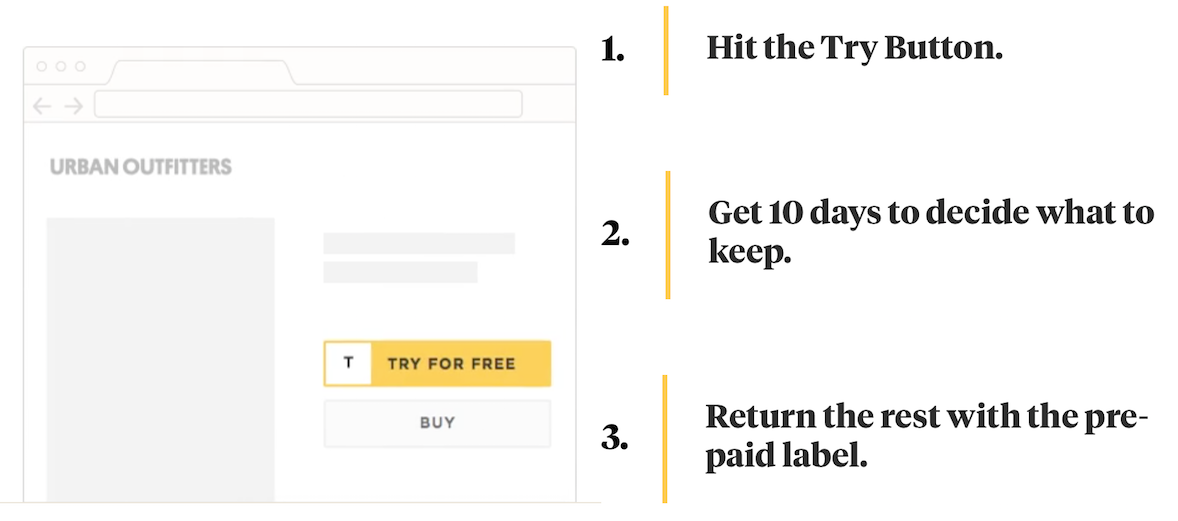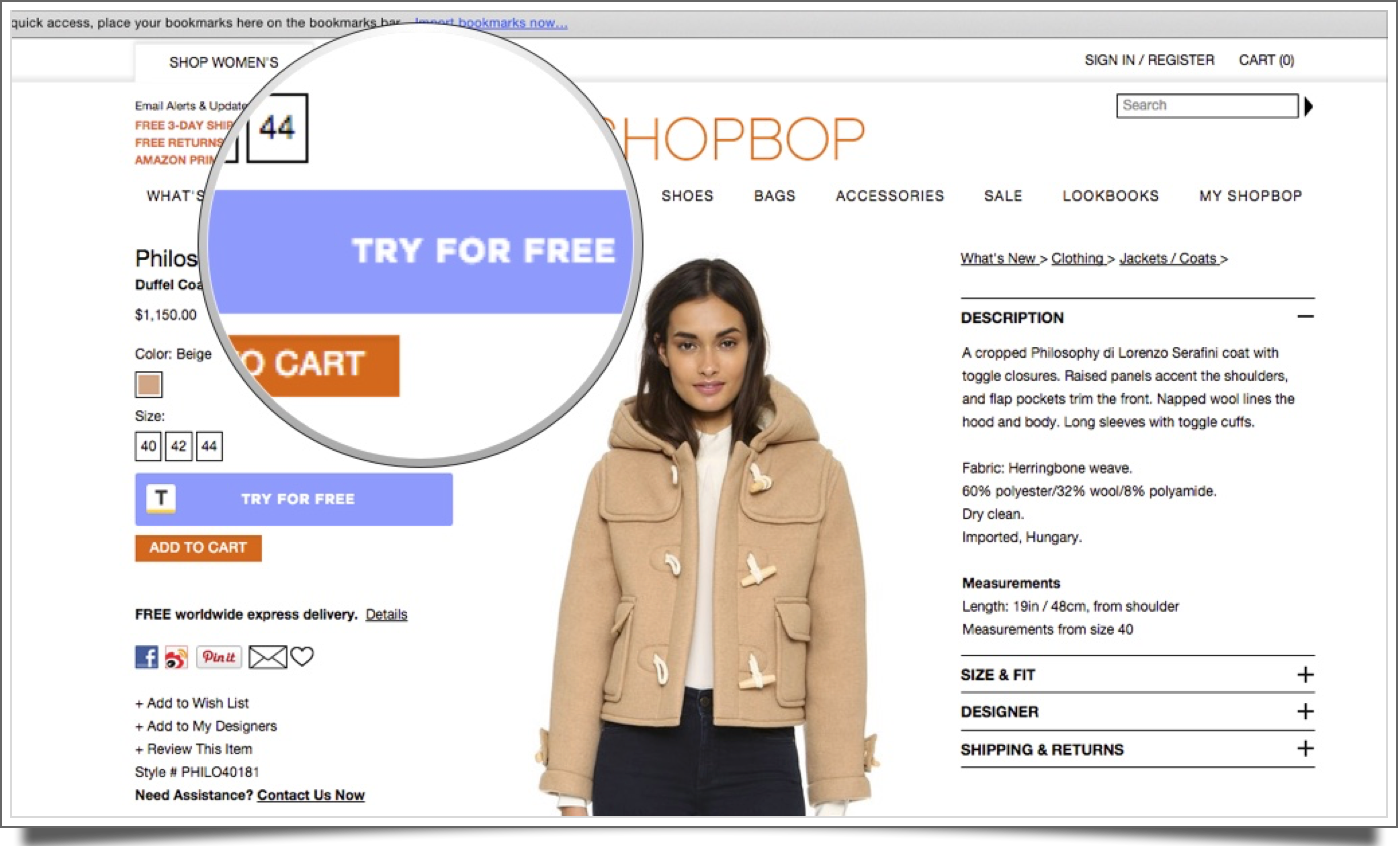Try.com wants to make money on fitting clothes

A few days ago, a new service Try.com was announced on Product Hunt, and I want to talk about it. This post is an attempt to systematize official project information and data from disparate sources, which I hope will help you to quickly understand its essence and business model.
Try.com's main valuable offer is a free fitting of goods from online stores. At the moment, the service works only in the USA and only with stores from the fashion segment. As the developers themselves say, it was decided to go from the stores in the upper price segment to cheaper ones.
')
I consider it important to disclose that I have no relation to this service. The article pursues a purely research purpose, namely, gathering information for launching its own project in an identical niche.
The task of the service is to increase the average bill in the stores, as it is expected that buyers will think less about adding goods to the order if it is known that they will not have to pay for them immediately. Returning goods in the remote mode of trading is not something new and unusual. The process of refusal of the goods is well described in the legislation on the protection of the rights of consumers of most developed countries: the United States is no exception. Nonetheless, customers perceive sending unsuccessful goods back to the store as a time consuming and unpleasant procedure.
It should be noted that all the popular stores in the United States are trying by all means to simplify the lives of their customers and have long been investing in the box with the goods a postage stamp to design a free return of things. This approach solves the problem only in part. The client can return the goods, but he will not receive the money back immediately. In addition, consumers have developed a very persistent negative attitude towards the above process, largely due to past negative experiences.
If you dig deeper, Try.com plays precisely on the psychological aspect of the purchase.
Psychological perception of the possibility to try something for free without risk and obligations is something intangible, something inexplicable in words. But it is worth trying it yourself, as everything becomes clear.
In essence, Try.com finances a purchase instead of a client, waits for a decision on each item that the buyer wants to leave or return, and only then removes the necessary amount from his card. Calculations with the store are made without the participation of the buyer. It is essential that the service itself is not engaged in the delivery of goods or its return. This task falls entirely on the shoulders of the store and is carried out by its standard means. That is why Try.com now works only with stores that offer free shipping and returns. By the way, there are not so many of them even in the USA.
The obvious way to monetize the service is to use affiliate links, which is confirmed by the founders themselves and they say that this is still the only method used.
You can also guess about other methods of monetization, for example, a project may receive a discount from stores of 2 to 3% from the order, since this amount will be saved on the fee for processing card payments. There are many other options - among them there is a sale of data about “reliable” buyers, which is indirectly confirmed by the commentary of one of the creators. Answering the user's question on Product Hunt, he said that based on the statistics of purchases and redemptions, each user receives a rating that affects the functions provided. What exactly, he did not report, but the most obvious are:
- The number of things that you can "try on." New users have the opportunity to try no more than 5 things in order.
- The allowed total amount of the order.
He also added that the reliability rating of the buyer becomes all the more relevant, the higher the cost of goods shipped.
NB In Russia, the problem of sending goods by cash on delivery has been very acute for several years. With the growing popularity of online commerce, the number of scammers is also increasing proportionally.
Apparently, the project plans to focus precisely on the rating of customer confidence, at least this follows from the CEO comment:
The traditional e-commerce model was created for a world in which the concept of trust did not exist and there was no data capable of replacing this trust. Now the amount of openly available information and advances in methods of fraud prevention are able to provide all the necessary information to create a customer profile of reliability.
The idea of Try.com seems slim, but a reasonable question arises. If the stores themselves are already able to successfully accept payments, deliver and process returns, what is the benefit for them of working with the service? It turns out that he does not bring any additional value?
At first glance, this is exactly what may seem, although, in fact, according to the founders, the service increases the average bill and net revenue. After all, he encourages customers to try more goods than they would agree to pay for them on their own if necessary. The store gets the money, so revenue is growing. One of the main problems of retailers is that customers click on the “Buy” button, add products to the cart, but never complete the purchase process. Try.com is designed to eliminate customer doubts when placing an order, because they do not lose anything.
In the process of testing, it turned out an interesting fact. If you postpone the moment of payment (for example, when the goods are already at the home of the buyer), the probability of buying is much higher. This is understandable, because the client can touch and feel the product. For goods in which he was not sure, the same mechanic works. Try.com increases the chances that they will be left.
The co-founder of the project, Arush Segal, highlighted two key problems that shops had already encountered that tried to independently provide a free fitting service:
- The motivation of "honest behavior" among customers and sending goods to those who are more likely to not return them.
- Automation and implementation of money back into existing e-commerce platforms.
It seems that Try.com solves all these problems. But what does the project look like in terms of a regular user?
First you need to go through a quick registration, during which you will need to enter your email, mobile phone, one or several delivery addresses and credit card information. Let me remind you that the service works so far only in the United States. Next, you need to install apps for Google Chrome. Other browsers are not supported yet.

The application adds a "Try for free" button (English "Try it for free" ) on all product cards in supported online stores . At first it may seem that this button conflicts with the standard “Buy now”, but according to Arush, the Try.com button actually helps sellers. He says that each company has different goals, but in the online retailer the main metrics are conversion, new customers and gross revenues. Nevertheless, the most important goal, he considers the simplification of purchases on the Internet for the average user.
At first there was no free delivery, now it is a common phenomenon. There was a time when returning an unsuitable product was a headache, Zappos was the first to simplify this process. Now it's time to simplify purchases with free fitting and make online shopping as similar as possible to purchases in ordinary shopping centers, making it as accessible as possible to the widest audience. An interesting feature of the application is that you can choose more than one size of the product you like.

It's time to ask the question, how much are the services of Try.com? They are free. The key idea of the service is to give more than the user expects, and not ask for money for it. Raise the expectations of the average buyer to a new level, yet unattainable for most online stores.
Interestingly, the story of how Try.com itself is interesting and deserves a separate article, as it shows the path of development of a startup from the first customers through the stages of selecting key functions and ending with the transformation into a completely new product with a different positioning. BRANDiD's metamorphosis in Try.com is very interesting. If the Magamind's readers are interested, I will collect the material and prepare the article.
Source: https://habr.com/ru/post/292474/
All Articles